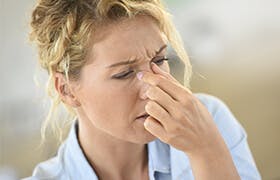
How Do We Breathe? Respiratory & Breathing Process.
Breathing consists of two phases: breathing in (inhalation) and breathing out (exhalation). Breathing involves the movement of air into and out of the chest, and is also called ventilation. The term respiration relates to the exchange of gases in the lungs that happens when you breathe.1
What function does the nose have in breathing?
Your nose helps filter the air you inhale before it reaches the lungs.
Air may contain pollutants such as:
- Allergens:3,4

Pollen

Dust mites

Pet dander
- Air pollutants:

Particulate matter such as dust5

Gaseous pollutants such as ozone (O3), nitrogen dioxide (NO2) and sulphur dioxide (SO2)5

Volatile organic compounds released from common household products such as detergents, paints and fuels6
- Pathogens:3

Viruses

Bacteria
Nostrils are lined with a number of hairs which help prevent particles from entering the nasal passages and delicate lung tissue.7
The impurities get trapped into the sticky nasal mucus inside our noses, and the cilia (tiny hair-like structure on the inside of your nose) clears the particles away towards the back of the throat to be swallowed or coughed out.7
The nose also defends the lower airways by acting as an air conditioner. The nose warms, filters, and humidifies the air so that clean, moist air at a comfortable temperature of 37°C is delivered to the lungs.3

How does the nose filter impurities from the air we breathe?
The nose is a really good filter of particles in the air. One way that the nose does this is due to the fact that air changes direction through 90 degrees when it passes from the entrance into the main space of the nose (the nasal cavity). This sudden change spins suspended matter out of the main air stream and onto the sticky surface of the inside of the nose.3
Secondly, the airflow speeds up as it passes through the nostrils (the narrowest part of the nose) and then slows as the air stream enters the nasal cavity. The changes in direction and speed of the air stream happen over the same area of the nose, and the slowing of the airflow at this point deposits particles from the air onto the skin inside the nose.3
How does a blocked nose affect breathing?
If the mucous membrane in your nose becomes irritated, causing inflammation, you tend to end up with a stuffy, or blocked nose. This makes breathing through your nose difficult, making it hard to sleep and making you feel tired.8
Using a nasal decongestant can help you relieve congestion and breathe more easily, day and night. The main active ingredient in Otrivin Adult Nasal Spray is xylometazoline, which starts to relieve nasal congestion in 5 minutes and continues to work for up to 10 hours.8
Xylometazoline acts directly on the blood vessels that line the nose. By working directly on the affected area, it can quickly reduce swelling, drain the sinuses and relieve congestion.8
References:
- Novotny S, Kravitz L. The Science of Breathing. Available from: https://www.unm.edu/~lkravitz/Article%20folder/Breathing.html (last accessed March 2020)
- British Lung Foundation. How your lungs work. Why do you breathe? Available from: https://www.blf.org.uk/support-for-you/how-your-lungs-work/why-do-we-breathe (last accessed March 2020)
- Eccles, R. 2009. The nose and control of nasal airflow. In: Adkinson N, Bochner B, Burks A, Busse W, Holgate S, Lemanske R, O'Hehir R, eds. Middleton’s Allergy, Principles and Practice, 8thedn - Vol. 1. Philadelphia: Mosby, 640 – 51
- World Allergy Organization. White Book on Allergy: Update 2013. Available from: https://www.worldallergy.org/wao-white-book-on-allergy (last accessed March 2020)
- World Health Organisation. Ambient (outdoor) air quality and health. Available from: https://www.who.int/airpollution/en/ (last accessed March 2020)
- United States Environmental Protection Agency. Volatile organic compounds' impact on indoor air quality. Available at: https://www.epa.gov/indoor-air-quality-iaq/volatile-organic-compounds-impact-indoor-air-quality (last accessed March 2020)
- Jones N. Adv Drug Deliv Rev. 2001;51:5–19
- Eccles R, Martenssen K, Chen S. Effects of intranasal xylometazoline, alone or in combination with ipratropium, in patients with common cold. Curr Med Res Opin. 2010;26:889–899
Show all references
Close references





